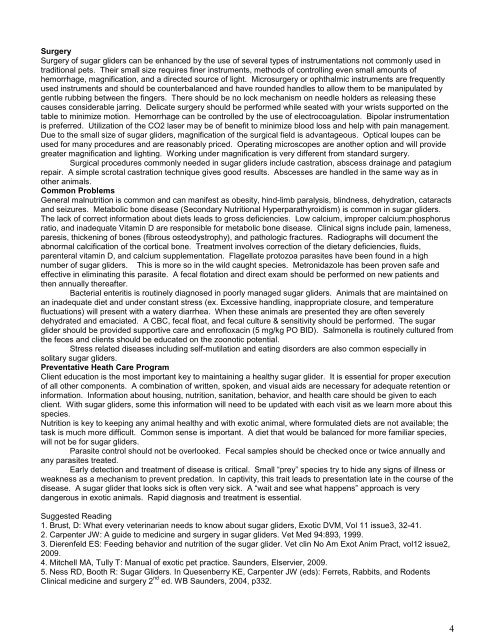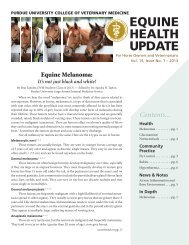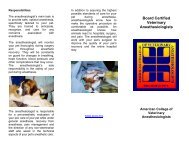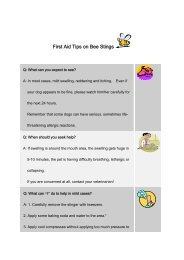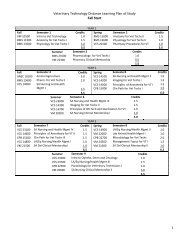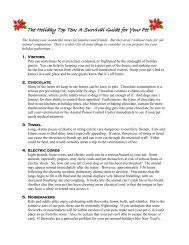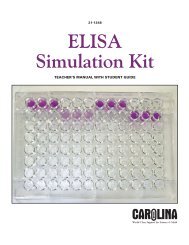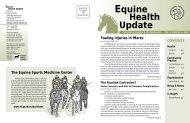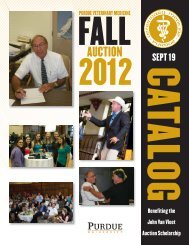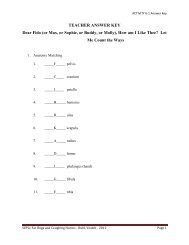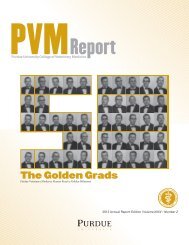Sugar Gliders - Purdue University School of Veterinary Medicine
Sugar Gliders - Purdue University School of Veterinary Medicine
Sugar Gliders - Purdue University School of Veterinary Medicine
Create successful ePaper yourself
Turn your PDF publications into a flip-book with our unique Google optimized e-Paper software.
Surgery<br />
Surgery <strong>of</strong> sugar gliders can be enhanced by the use <strong>of</strong> several types <strong>of</strong> instrumentations not commonly used in<br />
traditional pets. Their small size requires finer instruments, methods <strong>of</strong> controlling even small amounts <strong>of</strong><br />
hemorrhage, magnification, and a directed source <strong>of</strong> light. Microsurgery or ophthalmic instruments are frequently<br />
used instruments and should be counterbalanced and have rounded handles to allow them to be manipulated by<br />
gentle rubbing between the fingers. There should be no lock mechanism on needle holders as releasing these<br />
causes considerable jarring. Delicate surgery should be performed while seated with your wrists supported on the<br />
table to minimize motion. Hemorrhage can be controlled by the use <strong>of</strong> electrocoagulation. Bipolar instrumentation<br />
is preferred. Utilization <strong>of</strong> the CO2 laser may be <strong>of</strong> benefit to minimize blood loss and help with pain management.<br />
Due to the small size <strong>of</strong> sugar gliders, magnification <strong>of</strong> the surgical field is advantageous. Optical loupes can be<br />
used for many procedures and are reasonably priced. Operating microscopes are another option and will provide<br />
greater magnification and lighting. Working under magnification is very different from standard surgery.<br />
Surgical procedures commonly needed in sugar gliders include castration, abscess drainage and patagium<br />
repair. A simple scrotal castration technique gives good results. Abscesses are handled in the same way as in<br />
other animals.<br />
Common Problems<br />
General malnutrition is common and can manifest as obesity, hind-limb paralysis, blindness, dehydration, cataracts<br />
and seizures. Metabolic bone disease (Secondary Nutritional Hyperparathyroidism) is common in sugar gliders.<br />
The lack <strong>of</strong> correct information about diets leads to gross deficiencies. Low calcium, improper calcium:phosphorus<br />
ratio, and inadequate Vitamin D are responsible for metabolic bone disease. Clinical signs include pain, lameness,<br />
paresis, thickening <strong>of</strong> bones (fibrous osteodystrophy), and pathologic fractures. Radiographs will document the<br />
abnormal calcification <strong>of</strong> the cortical bone. Treatment involves correction <strong>of</strong> the dietary deficiencies, fluids,<br />
parenteral vitamin D, and calcium supplementation. Flagellate protozoa parasites have been found in a high<br />
number <strong>of</strong> sugar gliders. This is more so in the wild caught species. Metronidazole has been proven safe and<br />
effective in eliminating this parasite. A fecal flotation and direct exam should be performed on new patients and<br />
then annually thereafter.<br />
Bacterial enteritis is routinely diagnosed in poorly managed sugar gliders. Animals that are maintained on<br />
an inadequate diet and under constant stress (ex. Excessive handling, inappropriate closure, and temperature<br />
fluctuations) will present with a watery diarrhea. When these animals are presented they are <strong>of</strong>ten severely<br />
dehydrated and emaciated. A CBC, fecal float, and fecal culture & sensitivity should be performed. The sugar<br />
glider should be provided supportive care and enr<strong>of</strong>loxacin (5 mg/kg PO BID). Salmonella is routinely cultured from<br />
the feces and clients should be educated on the zoonotic potential.<br />
Stress related diseases including self-mutilation and eating disorders are also common especially in<br />
solitary sugar gliders.<br />
Preventative Heath Care Program<br />
Client education is the most important key to maintaining a healthy sugar glider. It is essential for proper execution<br />
<strong>of</strong> all other components. A combination <strong>of</strong> written, spoken, and visual aids are necessary for adequate retention or<br />
information. Information about housing, nutrition, sanitation, behavior, and health care should be given to each<br />
client. With sugar gliders, some this information will need to be updated with each visit as we learn more about this<br />
species.<br />
Nutrition is key to keeping any animal healthy and with exotic animal, where formulated diets are not available; the<br />
task is much more difficult. Common sense is important. A diet that would be balanced for more familiar species,<br />
will not be for sugar gliders.<br />
Parasite control should not be overlooked. Fecal samples should be checked once or twice annually and<br />
any parasites treated.<br />
Early detection and treatment <strong>of</strong> disease is critical. Small “prey” species try to hide any signs <strong>of</strong> illness or<br />
weakness as a mechanism to prevent predation. In captivity, this trait leads to presentation late in the course <strong>of</strong> the<br />
disease. A sugar glider that looks sick is <strong>of</strong>ten very sick. A “wait and see what happens” approach is very<br />
dangerous in exotic animals. Rapid diagnosis and treatment is essential.<br />
Suggested Reading<br />
1. Brust, D: What every veterinarian needs to know about sugar gliders, Exotic DVM, Vol 11 issue3, 32-41.<br />
2. Carpenter JW: A guide to medicine and surgery in sugar gliders. Vet Med 94:893, 1999.<br />
3. Dierenfeld ES: Feeding behavior and nutrition <strong>of</strong> the sugar glider. Vet clin No Am Exot Anim Pract, vol12 issue2,<br />
2009.<br />
4. Mitchell MA, Tully T: Manual <strong>of</strong> exotic pet practice. Saunders, Elservier, 2009.<br />
5. Ness RD, Booth R: <strong>Sugar</strong> <strong>Gliders</strong>. In Quesenberry KE, Carpenter JW (eds): Ferrets, Rabbits, and Rodents<br />
Clinical medicine and surgery 2 nd ed. WB Saunders, 2004, p332.<br />
4


